A Systematic Review: 12-Hour Shifts for Nurses - Burden or Boon?
VerifiedAdded on 2023/06/03
|37
|12407
|420
Report
AI Summary
This report presents a systematic review of 12 peer-reviewed articles to assess the impact of 12-hour working shifts on nurses' health, performance, and job satisfaction. The study investigates the causes of the increasing prevalence of these shifts, their influence on working efficiency and well-being, and the effects of prolonged work durations on fatigue and work-life balance. The research employs a post-positivism approach and secondary study methods, using databases such as NCBI, ProQuest, Medline, CINAHL, and SCOPUS. Findings indicate that rotational shift work increases the risk of coronary heart diseases, occupational stress affects nursing efficacy, and prolonged work has a detrimental impact on physical health. Night shifts also negatively affect working efficiency and increase BMI levels. The conclusion highlights the negative consequences of long working hours and rotational duties on nurses' emotional well-being and working efficiency. The report includes an introduction, background, research questions, aim and objectives, rationale, search strategy, philosophical worldviews, research design, approach, and methods, followed by a discussion of evidence, findings, analysis, implications, limitations, and conclusion. The appendices include a PRISMA flow diagram.
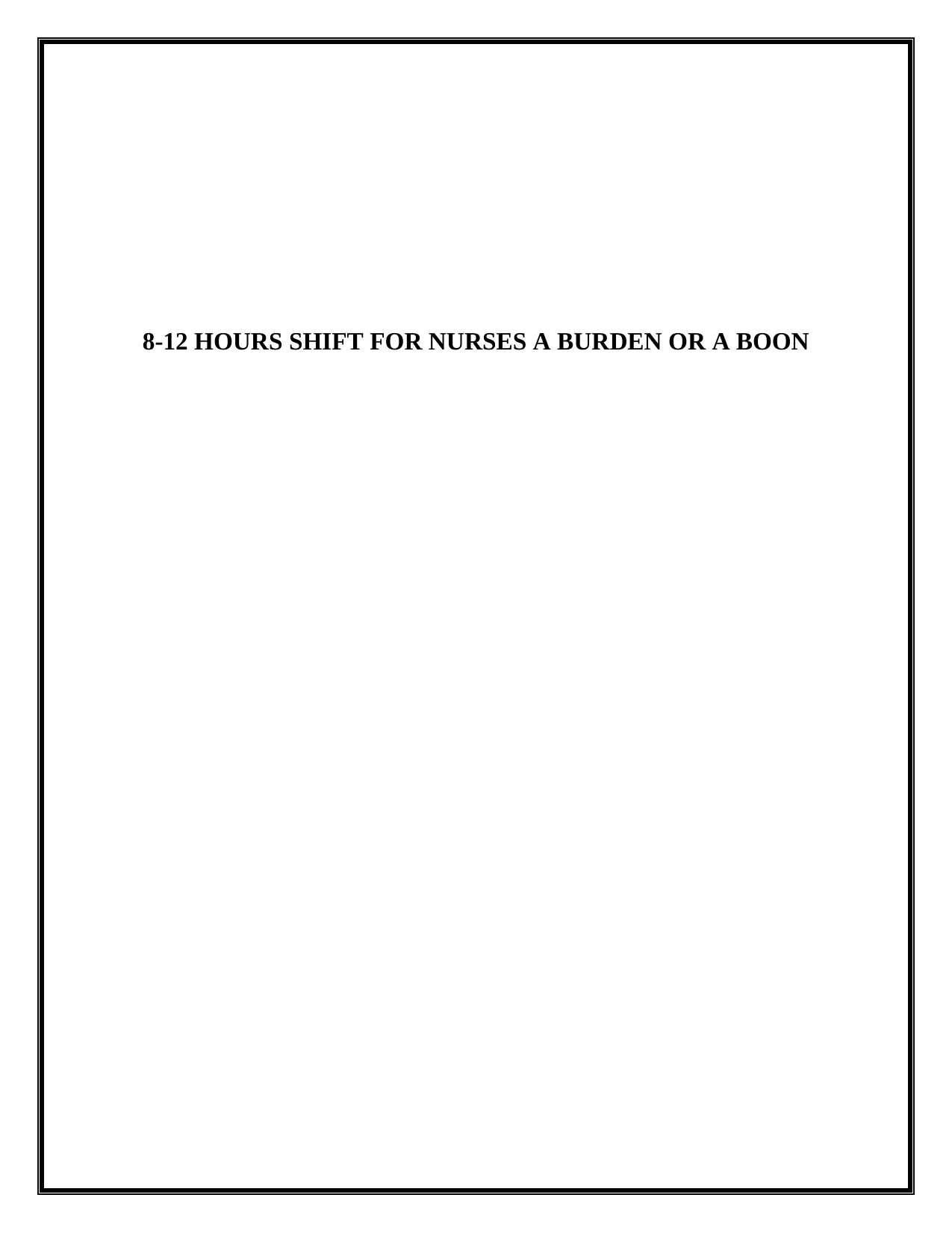
8-12 HOURS SHIFT FOR NURSES A BURDEN OR A BOON
Paraphrase This Document
Need a fresh take? Get an instant paraphrase of this document with our AI Paraphraser
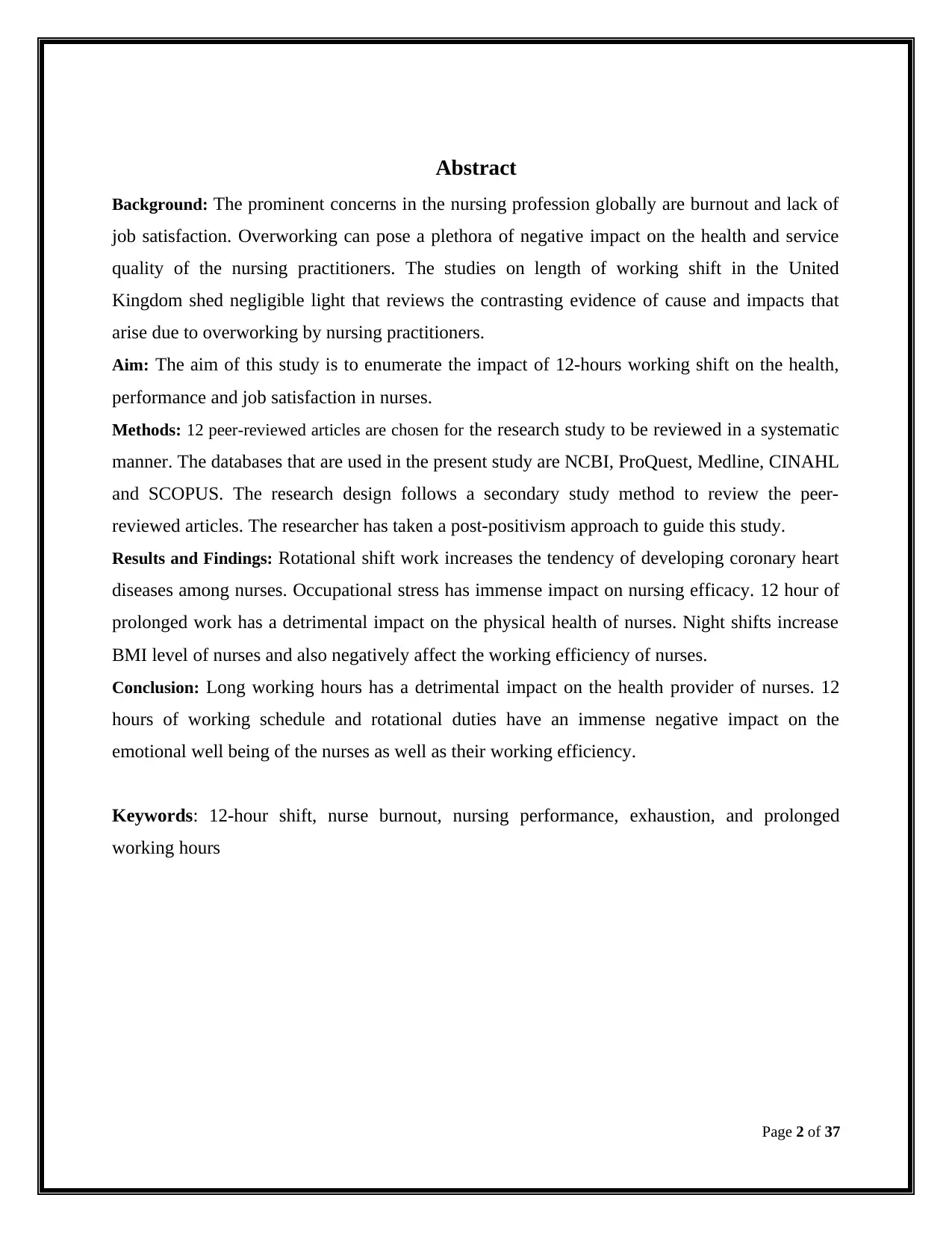
Abstract
Background: The prominent concerns in the nursing profession globally are burnout and lack of
job satisfaction. Overworking can pose a plethora of negative impact on the health and service
quality of the nursing practitioners. The studies on length of working shift in the United
Kingdom shed negligible light that reviews the contrasting evidence of cause and impacts that
arise due to overworking by nursing practitioners.
Aim: The aim of this study is to enumerate the impact of 12-hours working shift on the health,
performance and job satisfaction in nurses.
Methods: 12 peer-reviewed articles are chosen for the research study to be reviewed in a systematic
manner. The databases that are used in the present study are NCBI, ProQuest, Medline, CINAHL
and SCOPUS. The research design follows a secondary study method to review the peer-
reviewed articles. The researcher has taken a post-positivism approach to guide this study.
Results and Findings: Rotational shift work increases the tendency of developing coronary heart
diseases among nurses. Occupational stress has immense impact on nursing efficacy. 12 hour of
prolonged work has a detrimental impact on the physical health of nurses. Night shifts increase
BMI level of nurses and also negatively affect the working efficiency of nurses.
Conclusion: Long working hours has a detrimental impact on the health provider of nurses. 12
hours of working schedule and rotational duties have an immense negative impact on the
emotional well being of the nurses as well as their working efficiency.
Keywords: 12-hour shift, nurse burnout, nursing performance, exhaustion, and prolonged
working hours
Page 2 of 37
Background: The prominent concerns in the nursing profession globally are burnout and lack of
job satisfaction. Overworking can pose a plethora of negative impact on the health and service
quality of the nursing practitioners. The studies on length of working shift in the United
Kingdom shed negligible light that reviews the contrasting evidence of cause and impacts that
arise due to overworking by nursing practitioners.
Aim: The aim of this study is to enumerate the impact of 12-hours working shift on the health,
performance and job satisfaction in nurses.
Methods: 12 peer-reviewed articles are chosen for the research study to be reviewed in a systematic
manner. The databases that are used in the present study are NCBI, ProQuest, Medline, CINAHL
and SCOPUS. The research design follows a secondary study method to review the peer-
reviewed articles. The researcher has taken a post-positivism approach to guide this study.
Results and Findings: Rotational shift work increases the tendency of developing coronary heart
diseases among nurses. Occupational stress has immense impact on nursing efficacy. 12 hour of
prolonged work has a detrimental impact on the physical health of nurses. Night shifts increase
BMI level of nurses and also negatively affect the working efficiency of nurses.
Conclusion: Long working hours has a detrimental impact on the health provider of nurses. 12
hours of working schedule and rotational duties have an immense negative impact on the
emotional well being of the nurses as well as their working efficiency.
Keywords: 12-hour shift, nurse burnout, nursing performance, exhaustion, and prolonged
working hours
Page 2 of 37

Table of Contents
Part 1 4
Introduction.............................................................................................................................. 4
Background.............................................................................................................................. 4
Research question................................................................................................................... 5
Aim and objectives................................................................................................................... 5
Rationale.................................................................................................................................. 5
Search strategy........................................................................................................................ 8
Philosophical worldviews......................................................................................................8
Research design...................................................................................................................9
Research approach.............................................................................................................. 9
Research method.....................................................................................................................9
Part 2 11
Discussion of evidence...........................................................................................................16
Findings.............................................................................................................................. 16
Analysis.............................................................................................................................. 23
Implications and limitations....................................................................................................25
Conclusion............................................................................................................................. 26
References 27
Appendices 32
Appendix A: PRISMA............................................................................................................. 32
Page 3 of 37
Part 1 4
Introduction.............................................................................................................................. 4
Background.............................................................................................................................. 4
Research question................................................................................................................... 5
Aim and objectives................................................................................................................... 5
Rationale.................................................................................................................................. 5
Search strategy........................................................................................................................ 8
Philosophical worldviews......................................................................................................8
Research design...................................................................................................................9
Research approach.............................................................................................................. 9
Research method.....................................................................................................................9
Part 2 11
Discussion of evidence...........................................................................................................16
Findings.............................................................................................................................. 16
Analysis.............................................................................................................................. 23
Implications and limitations....................................................................................................25
Conclusion............................................................................................................................. 26
References 27
Appendices 32
Appendix A: PRISMA............................................................................................................. 32
Page 3 of 37
⊘ This is a preview!⊘
Do you want full access?
Subscribe today to unlock all pages.

Trusted by 1+ million students worldwide
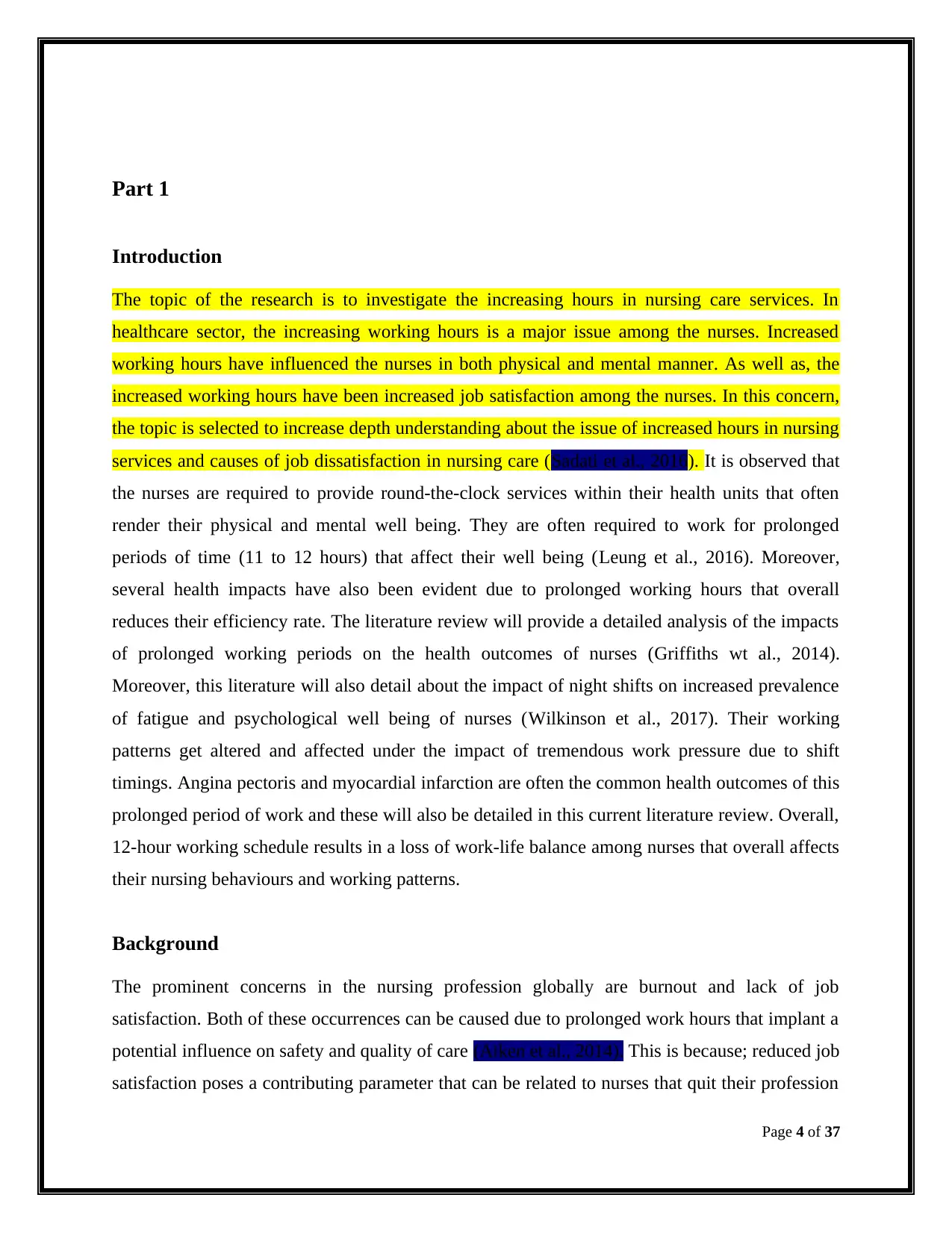
Part 1
Introduction
The topic of the research is to investigate the increasing hours in nursing care services. In
healthcare sector, the increasing working hours is a major issue among the nurses. Increased
working hours have influenced the nurses in both physical and mental manner. As well as, the
increased working hours have been increased job satisfaction among the nurses. In this concern,
the topic is selected to increase depth understanding about the issue of increased hours in nursing
services and causes of job dissatisfaction in nursing care (Sadati et al., 2016). It is observed that
the nurses are required to provide round-the-clock services within their health units that often
render their physical and mental well being. They are often required to work for prolonged
periods of time (11 to 12 hours) that affect their well being (Leung et al., 2016). Moreover,
several health impacts have also been evident due to prolonged working hours that overall
reduces their efficiency rate. The literature review will provide a detailed analysis of the impacts
of prolonged working periods on the health outcomes of nurses (Griffiths wt al., 2014).
Moreover, this literature will also detail about the impact of night shifts on increased prevalence
of fatigue and psychological well being of nurses (Wilkinson et al., 2017). Their working
patterns get altered and affected under the impact of tremendous work pressure due to shift
timings. Angina pectoris and myocardial infarction are often the common health outcomes of this
prolonged period of work and these will also be detailed in this current literature review. Overall,
12-hour working schedule results in a loss of work-life balance among nurses that overall affects
their nursing behaviours and working patterns.
Background
The prominent concerns in the nursing profession globally are burnout and lack of job
satisfaction. Both of these occurrences can be caused due to prolonged work hours that implant a
potential influence on safety and quality of care (Aiken et al., 2014). This is because; reduced job
satisfaction poses a contributing parameter that can be related to nurses that quit their profession
Page 4 of 37
Introduction
The topic of the research is to investigate the increasing hours in nursing care services. In
healthcare sector, the increasing working hours is a major issue among the nurses. Increased
working hours have influenced the nurses in both physical and mental manner. As well as, the
increased working hours have been increased job satisfaction among the nurses. In this concern,
the topic is selected to increase depth understanding about the issue of increased hours in nursing
services and causes of job dissatisfaction in nursing care (Sadati et al., 2016). It is observed that
the nurses are required to provide round-the-clock services within their health units that often
render their physical and mental well being. They are often required to work for prolonged
periods of time (11 to 12 hours) that affect their well being (Leung et al., 2016). Moreover,
several health impacts have also been evident due to prolonged working hours that overall
reduces their efficiency rate. The literature review will provide a detailed analysis of the impacts
of prolonged working periods on the health outcomes of nurses (Griffiths wt al., 2014).
Moreover, this literature will also detail about the impact of night shifts on increased prevalence
of fatigue and psychological well being of nurses (Wilkinson et al., 2017). Their working
patterns get altered and affected under the impact of tremendous work pressure due to shift
timings. Angina pectoris and myocardial infarction are often the common health outcomes of this
prolonged period of work and these will also be detailed in this current literature review. Overall,
12-hour working schedule results in a loss of work-life balance among nurses that overall affects
their nursing behaviours and working patterns.
Background
The prominent concerns in the nursing profession globally are burnout and lack of job
satisfaction. Both of these occurrences can be caused due to prolonged work hours that implant a
potential influence on safety and quality of care (Aiken et al., 2014). This is because; reduced job
satisfaction poses a contributing parameter that can be related to nurses that quit their profession
Page 4 of 37
Paraphrase This Document
Need a fresh take? Get an instant paraphrase of this document with our AI Paraphraser
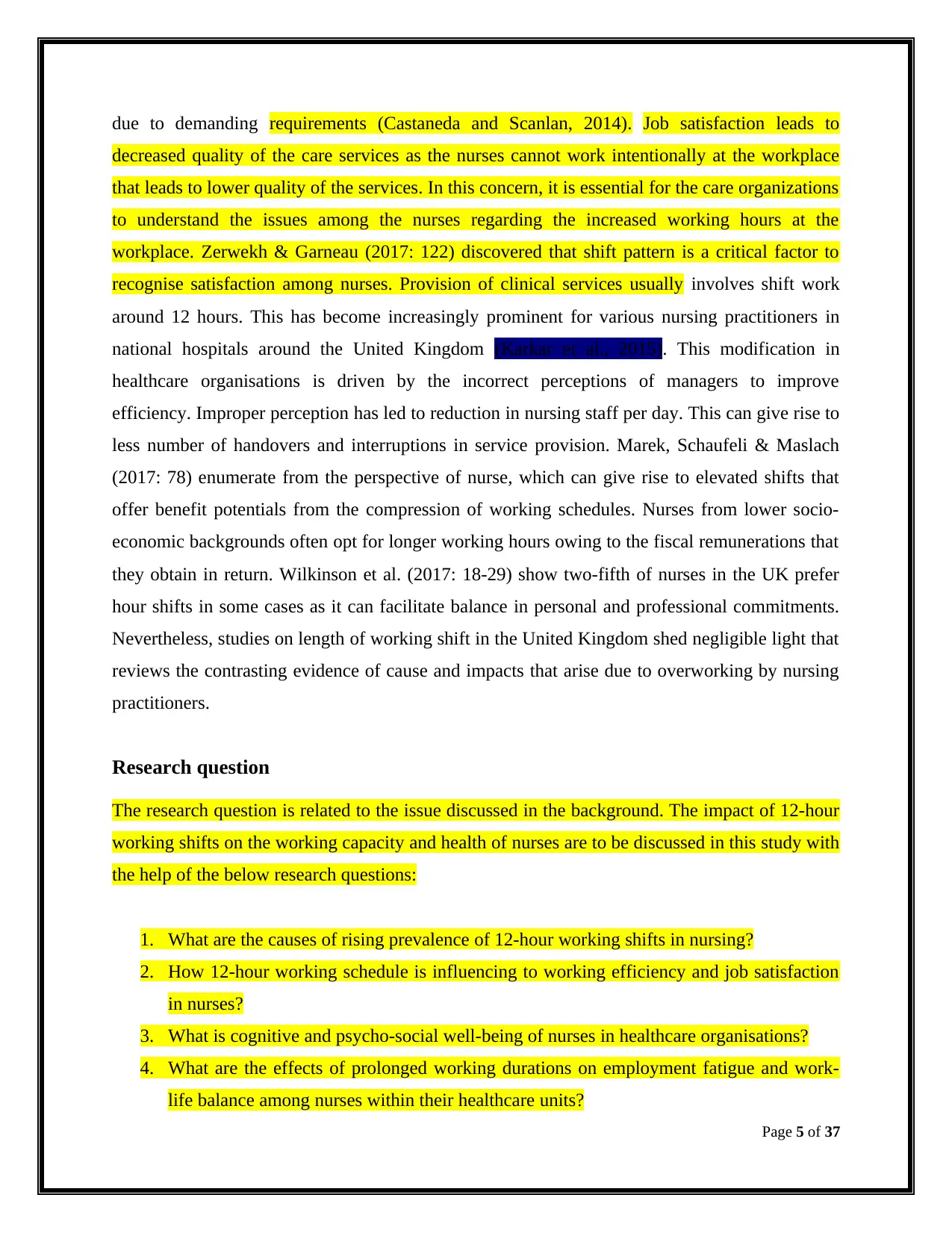
due to demanding requirements (Castaneda and Scanlan, 2014). Job satisfaction leads to
decreased quality of the care services as the nurses cannot work intentionally at the workplace
that leads to lower quality of the services. In this concern, it is essential for the care organizations
to understand the issues among the nurses regarding the increased working hours at the
workplace. Zerwekh & Garneau (2017: 122) discovered that shift pattern is a critical factor to
recognise satisfaction among nurses. Provision of clinical services usually involves shift work
around 12 hours. This has become increasingly prominent for various nursing practitioners in
national hospitals around the United Kingdom (Karkar et al., 2015). This modification in
healthcare organisations is driven by the incorrect perceptions of managers to improve
efficiency. Improper perception has led to reduction in nursing staff per day. This can give rise to
less number of handovers and interruptions in service provision. Marek, Schaufeli & Maslach
(2017: 78) enumerate from the perspective of nurse, which can give rise to elevated shifts that
offer benefit potentials from the compression of working schedules. Nurses from lower socio-
economic backgrounds often opt for longer working hours owing to the fiscal remunerations that
they obtain in return. Wilkinson et al. (2017: 18-29) show two-fifth of nurses in the UK prefer
hour shifts in some cases as it can facilitate balance in personal and professional commitments.
Nevertheless, studies on length of working shift in the United Kingdom shed negligible light that
reviews the contrasting evidence of cause and impacts that arise due to overworking by nursing
practitioners.
Research question
The research question is related to the issue discussed in the background. The impact of 12-hour
working shifts on the working capacity and health of nurses are to be discussed in this study with
the help of the below research questions:
1. What are the causes of rising prevalence of 12-hour working shifts in nursing?
2. How 12-hour working schedule is influencing to working efficiency and job satisfaction
in nurses?
3. What is cognitive and psycho-social well-being of nurses in healthcare organisations?
4. What are the effects of prolonged working durations on employment fatigue and work-
life balance among nurses within their healthcare units?
Page 5 of 37
decreased quality of the care services as the nurses cannot work intentionally at the workplace
that leads to lower quality of the services. In this concern, it is essential for the care organizations
to understand the issues among the nurses regarding the increased working hours at the
workplace. Zerwekh & Garneau (2017: 122) discovered that shift pattern is a critical factor to
recognise satisfaction among nurses. Provision of clinical services usually involves shift work
around 12 hours. This has become increasingly prominent for various nursing practitioners in
national hospitals around the United Kingdom (Karkar et al., 2015). This modification in
healthcare organisations is driven by the incorrect perceptions of managers to improve
efficiency. Improper perception has led to reduction in nursing staff per day. This can give rise to
less number of handovers and interruptions in service provision. Marek, Schaufeli & Maslach
(2017: 78) enumerate from the perspective of nurse, which can give rise to elevated shifts that
offer benefit potentials from the compression of working schedules. Nurses from lower socio-
economic backgrounds often opt for longer working hours owing to the fiscal remunerations that
they obtain in return. Wilkinson et al. (2017: 18-29) show two-fifth of nurses in the UK prefer
hour shifts in some cases as it can facilitate balance in personal and professional commitments.
Nevertheless, studies on length of working shift in the United Kingdom shed negligible light that
reviews the contrasting evidence of cause and impacts that arise due to overworking by nursing
practitioners.
Research question
The research question is related to the issue discussed in the background. The impact of 12-hour
working shifts on the working capacity and health of nurses are to be discussed in this study with
the help of the below research questions:
1. What are the causes of rising prevalence of 12-hour working shifts in nursing?
2. How 12-hour working schedule is influencing to working efficiency and job satisfaction
in nurses?
3. What is cognitive and psycho-social well-being of nurses in healthcare organisations?
4. What are the effects of prolonged working durations on employment fatigue and work-
life balance among nurses within their healthcare units?
Page 5 of 37

Aim and objectives
Due to the increased demand of the nurses in care organizations, the care organizations have
been increased the working hours of the nurses at the workplace to fulfil the demand. This
strategy influenced the working practices of the nurses as the nurses are working with mental
stress as they cannot spend time for their personal life in desired manner. It has influenced their
routine activities in big manner (National Health Service, 2017). In this concern, the aim of this
research is to critically discuss and enumerate the impact of 12-hours working shift on the health,
performance and job satisfaction in nurses. The cause of research on this topic or the aim is that
it will be helpful in understanding the working strategies of the care organizations. This aim will
be attained through the accomplishment of below objectives:
1. To enumerate the causes that has given rise to prevalence in 12-hours working shifts
2. To understand the impact of 12-hour working schedule on working efficiency and job
satisfaction among nurses
3. To analyse cognitive and psycho-social well-being of nurses who work in 12-hour shifts
in various healthcare organisations
4. To evaluate the effect of prolonged working durations on employment fatigue and work-
life balance among nurses within their healthcare units
Rationale
Prolonged working hours, such as twelve hours or more have gained prominence in health care
centres. However this practice is rarely evaluated from the perspective of job satisfaction and
working efficiency. In addition to this, prominent reviews have shed little light on the influence
of extended hours on long-term physical and emotional impact on nurses. Manzano-García &
Ayala (2017: 0175352) survey nurses in four hospitals that show 70% of nursing practitioners
are satisfied with practice schedules at hospitals. Nevertheless, nursing practitioners that work
for more than twelve hours have increased in the past five years. However, 12-hour of prolonged
work has aggravated the mental and physical wellbeing of nurses. Schmidt et al. (2014: 42-46)
state nurses that work for ten continuous hours or longer are 25% more exposed to the risk of
Page 6 of 37
Due to the increased demand of the nurses in care organizations, the care organizations have
been increased the working hours of the nurses at the workplace to fulfil the demand. This
strategy influenced the working practices of the nurses as the nurses are working with mental
stress as they cannot spend time for their personal life in desired manner. It has influenced their
routine activities in big manner (National Health Service, 2017). In this concern, the aim of this
research is to critically discuss and enumerate the impact of 12-hours working shift on the health,
performance and job satisfaction in nurses. The cause of research on this topic or the aim is that
it will be helpful in understanding the working strategies of the care organizations. This aim will
be attained through the accomplishment of below objectives:
1. To enumerate the causes that has given rise to prevalence in 12-hours working shifts
2. To understand the impact of 12-hour working schedule on working efficiency and job
satisfaction among nurses
3. To analyse cognitive and psycho-social well-being of nurses who work in 12-hour shifts
in various healthcare organisations
4. To evaluate the effect of prolonged working durations on employment fatigue and work-
life balance among nurses within their healthcare units
Rationale
Prolonged working hours, such as twelve hours or more have gained prominence in health care
centres. However this practice is rarely evaluated from the perspective of job satisfaction and
working efficiency. In addition to this, prominent reviews have shed little light on the influence
of extended hours on long-term physical and emotional impact on nurses. Manzano-García &
Ayala (2017: 0175352) survey nurses in four hospitals that show 70% of nursing practitioners
are satisfied with practice schedules at hospitals. Nevertheless, nursing practitioners that work
for more than twelve hours have increased in the past five years. However, 12-hour of prolonged
work has aggravated the mental and physical wellbeing of nurses. Schmidt et al. (2014: 42-46)
state nurses that work for ten continuous hours or longer are 25% more exposed to the risk of
Page 6 of 37
⊘ This is a preview!⊘
Do you want full access?
Subscribe today to unlock all pages.

Trusted by 1+ million students worldwide
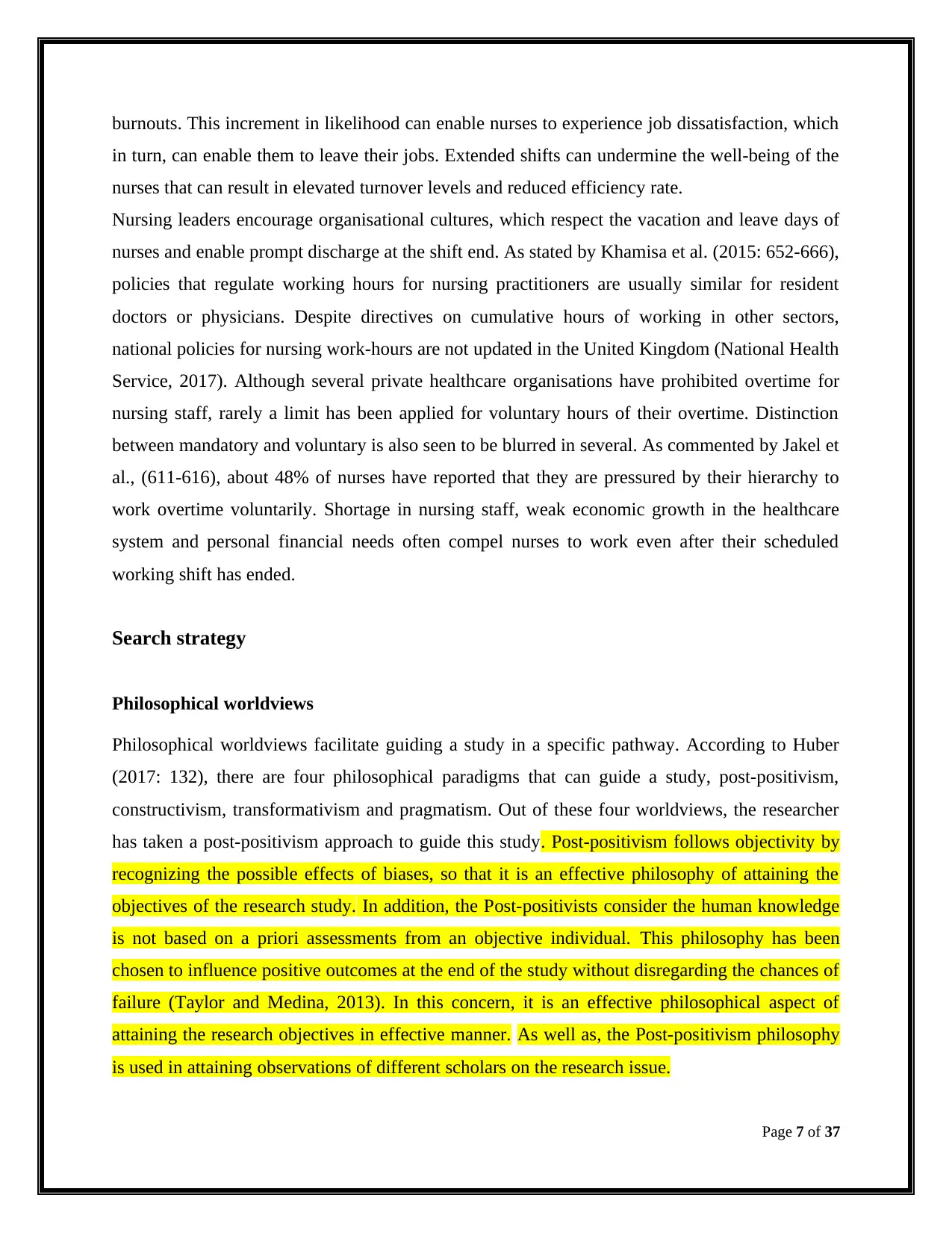
burnouts. This increment in likelihood can enable nurses to experience job dissatisfaction, which
in turn, can enable them to leave their jobs. Extended shifts can undermine the well-being of the
nurses that can result in elevated turnover levels and reduced efficiency rate.
Nursing leaders encourage organisational cultures, which respect the vacation and leave days of
nurses and enable prompt discharge at the shift end. As stated by Khamisa et al. (2015: 652-666),
policies that regulate working hours for nursing practitioners are usually similar for resident
doctors or physicians. Despite directives on cumulative hours of working in other sectors,
national policies for nursing work-hours are not updated in the United Kingdom (National Health
Service, 2017). Although several private healthcare organisations have prohibited overtime for
nursing staff, rarely a limit has been applied for voluntary hours of their overtime. Distinction
between mandatory and voluntary is also seen to be blurred in several. As commented by Jakel et
al., (611-616), about 48% of nurses have reported that they are pressured by their hierarchy to
work overtime voluntarily. Shortage in nursing staff, weak economic growth in the healthcare
system and personal financial needs often compel nurses to work even after their scheduled
working shift has ended.
Search strategy
Philosophical worldviews
Philosophical worldviews facilitate guiding a study in a specific pathway. According to Huber
(2017: 132), there are four philosophical paradigms that can guide a study, post-positivism,
constructivism, transformativism and pragmatism. Out of these four worldviews, the researcher
has taken a post-positivism approach to guide this study. Post-positivism follows objectivity by
recognizing the possible effects of biases, so that it is an effective philosophy of attaining the
objectives of the research study. In addition, the Post-positivists consider the human knowledge
is not based on a priori assessments from an objective individual. This philosophy has been
chosen to influence positive outcomes at the end of the study without disregarding the chances of
failure (Taylor and Medina, 2013). In this concern, it is an effective philosophical aspect of
attaining the research objectives in effective manner. As well as, the Post-positivism philosophy
is used in attaining observations of different scholars on the research issue.
Page 7 of 37
in turn, can enable them to leave their jobs. Extended shifts can undermine the well-being of the
nurses that can result in elevated turnover levels and reduced efficiency rate.
Nursing leaders encourage organisational cultures, which respect the vacation and leave days of
nurses and enable prompt discharge at the shift end. As stated by Khamisa et al. (2015: 652-666),
policies that regulate working hours for nursing practitioners are usually similar for resident
doctors or physicians. Despite directives on cumulative hours of working in other sectors,
national policies for nursing work-hours are not updated in the United Kingdom (National Health
Service, 2017). Although several private healthcare organisations have prohibited overtime for
nursing staff, rarely a limit has been applied for voluntary hours of their overtime. Distinction
between mandatory and voluntary is also seen to be blurred in several. As commented by Jakel et
al., (611-616), about 48% of nurses have reported that they are pressured by their hierarchy to
work overtime voluntarily. Shortage in nursing staff, weak economic growth in the healthcare
system and personal financial needs often compel nurses to work even after their scheduled
working shift has ended.
Search strategy
Philosophical worldviews
Philosophical worldviews facilitate guiding a study in a specific pathway. According to Huber
(2017: 132), there are four philosophical paradigms that can guide a study, post-positivism,
constructivism, transformativism and pragmatism. Out of these four worldviews, the researcher
has taken a post-positivism approach to guide this study. Post-positivism follows objectivity by
recognizing the possible effects of biases, so that it is an effective philosophy of attaining the
objectives of the research study. In addition, the Post-positivists consider the human knowledge
is not based on a priori assessments from an objective individual. This philosophy has been
chosen to influence positive outcomes at the end of the study without disregarding the chances of
failure (Taylor and Medina, 2013). In this concern, it is an effective philosophical aspect of
attaining the research objectives in effective manner. As well as, the Post-positivism philosophy
is used in attaining observations of different scholars on the research issue.
Page 7 of 37
Paraphrase This Document
Need a fresh take? Get an instant paraphrase of this document with our AI Paraphraser
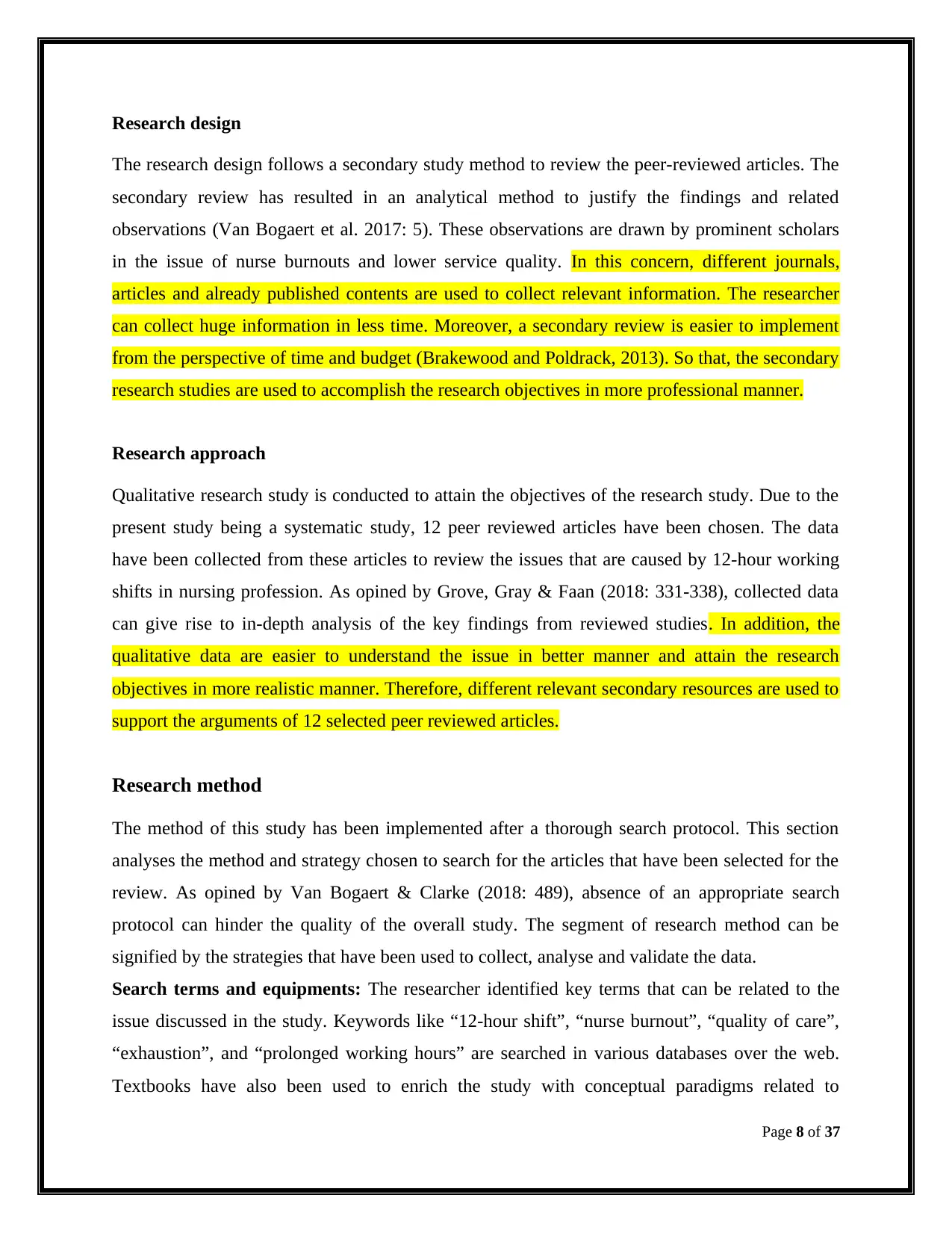
Research design
The research design follows a secondary study method to review the peer-reviewed articles. The
secondary review has resulted in an analytical method to justify the findings and related
observations (Van Bogaert et al. 2017: 5). These observations are drawn by prominent scholars
in the issue of nurse burnouts and lower service quality. In this concern, different journals,
articles and already published contents are used to collect relevant information. The researcher
can collect huge information in less time. Moreover, a secondary review is easier to implement
from the perspective of time and budget (Brakewood and Poldrack, 2013). So that, the secondary
research studies are used to accomplish the research objectives in more professional manner.
Research approach
Qualitative research study is conducted to attain the objectives of the research study. Due to the
present study being a systematic study, 12 peer reviewed articles have been chosen. The data
have been collected from these articles to review the issues that are caused by 12-hour working
shifts in nursing profession. As opined by Grove, Gray & Faan (2018: 331-338), collected data
can give rise to in-depth analysis of the key findings from reviewed studies. In addition, the
qualitative data are easier to understand the issue in better manner and attain the research
objectives in more realistic manner. Therefore, different relevant secondary resources are used to
support the arguments of 12 selected peer reviewed articles.
Research method
The method of this study has been implemented after a thorough search protocol. This section
analyses the method and strategy chosen to search for the articles that have been selected for the
review. As opined by Van Bogaert & Clarke (2018: 489), absence of an appropriate search
protocol can hinder the quality of the overall study. The segment of research method can be
signified by the strategies that have been used to collect, analyse and validate the data.
Search terms and equipments: The researcher identified key terms that can be related to the
issue discussed in the study. Keywords like “12-hour shift”, “nurse burnout”, “quality of care”,
“exhaustion”, and “prolonged working hours” are searched in various databases over the web.
Textbooks have also been used to enrich the study with conceptual paradigms related to
Page 8 of 37
The research design follows a secondary study method to review the peer-reviewed articles. The
secondary review has resulted in an analytical method to justify the findings and related
observations (Van Bogaert et al. 2017: 5). These observations are drawn by prominent scholars
in the issue of nurse burnouts and lower service quality. In this concern, different journals,
articles and already published contents are used to collect relevant information. The researcher
can collect huge information in less time. Moreover, a secondary review is easier to implement
from the perspective of time and budget (Brakewood and Poldrack, 2013). So that, the secondary
research studies are used to accomplish the research objectives in more professional manner.
Research approach
Qualitative research study is conducted to attain the objectives of the research study. Due to the
present study being a systematic study, 12 peer reviewed articles have been chosen. The data
have been collected from these articles to review the issues that are caused by 12-hour working
shifts in nursing profession. As opined by Grove, Gray & Faan (2018: 331-338), collected data
can give rise to in-depth analysis of the key findings from reviewed studies. In addition, the
qualitative data are easier to understand the issue in better manner and attain the research
objectives in more realistic manner. Therefore, different relevant secondary resources are used to
support the arguments of 12 selected peer reviewed articles.
Research method
The method of this study has been implemented after a thorough search protocol. This section
analyses the method and strategy chosen to search for the articles that have been selected for the
review. As opined by Van Bogaert & Clarke (2018: 489), absence of an appropriate search
protocol can hinder the quality of the overall study. The segment of research method can be
signified by the strategies that have been used to collect, analyse and validate the data.
Search terms and equipments: The researcher identified key terms that can be related to the
issue discussed in the study. Keywords like “12-hour shift”, “nurse burnout”, “quality of care”,
“exhaustion”, and “prolonged working hours” are searched in various databases over the web.
Textbooks have also been used to enrich the study with conceptual paradigms related to
Page 8 of 37
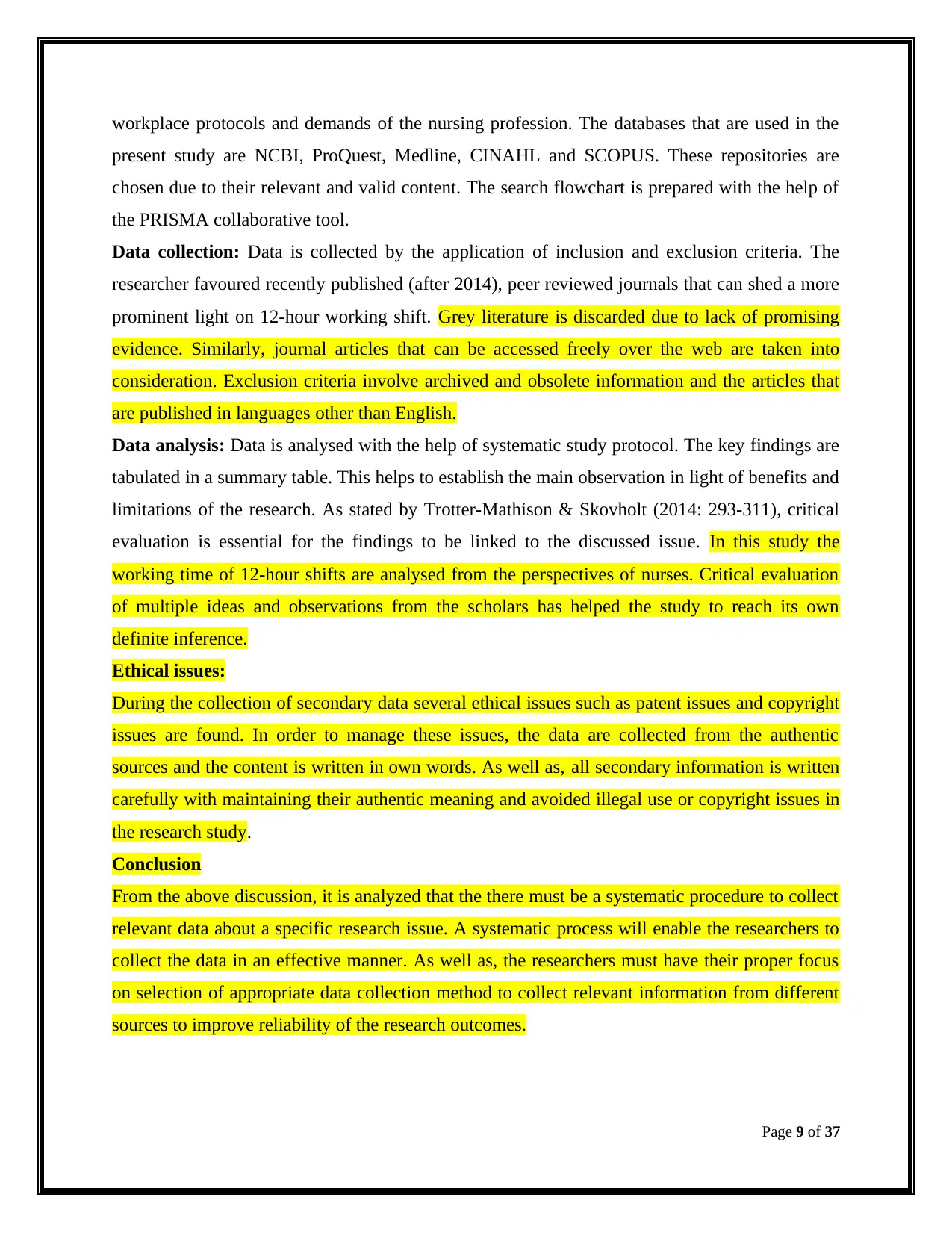
workplace protocols and demands of the nursing profession. The databases that are used in the
present study are NCBI, ProQuest, Medline, CINAHL and SCOPUS. These repositories are
chosen due to their relevant and valid content. The search flowchart is prepared with the help of
the PRISMA collaborative tool.
Data collection: Data is collected by the application of inclusion and exclusion criteria. The
researcher favoured recently published (after 2014), peer reviewed journals that can shed a more
prominent light on 12-hour working shift. Grey literature is discarded due to lack of promising
evidence. Similarly, journal articles that can be accessed freely over the web are taken into
consideration. Exclusion criteria involve archived and obsolete information and the articles that
are published in languages other than English.
Data analysis: Data is analysed with the help of systematic study protocol. The key findings are
tabulated in a summary table. This helps to establish the main observation in light of benefits and
limitations of the research. As stated by Trotter-Mathison & Skovholt (2014: 293-311), critical
evaluation is essential for the findings to be linked to the discussed issue. In this study the
working time of 12-hour shifts are analysed from the perspectives of nurses. Critical evaluation
of multiple ideas and observations from the scholars has helped the study to reach its own
definite inference.
Ethical issues:
During the collection of secondary data several ethical issues such as patent issues and copyright
issues are found. In order to manage these issues, the data are collected from the authentic
sources and the content is written in own words. As well as, all secondary information is written
carefully with maintaining their authentic meaning and avoided illegal use or copyright issues in
the research study.
Conclusion
From the above discussion, it is analyzed that the there must be a systematic procedure to collect
relevant data about a specific research issue. A systematic process will enable the researchers to
collect the data in an effective manner. As well as, the researchers must have their proper focus
on selection of appropriate data collection method to collect relevant information from different
sources to improve reliability of the research outcomes.
Page 9 of 37
present study are NCBI, ProQuest, Medline, CINAHL and SCOPUS. These repositories are
chosen due to their relevant and valid content. The search flowchart is prepared with the help of
the PRISMA collaborative tool.
Data collection: Data is collected by the application of inclusion and exclusion criteria. The
researcher favoured recently published (after 2014), peer reviewed journals that can shed a more
prominent light on 12-hour working shift. Grey literature is discarded due to lack of promising
evidence. Similarly, journal articles that can be accessed freely over the web are taken into
consideration. Exclusion criteria involve archived and obsolete information and the articles that
are published in languages other than English.
Data analysis: Data is analysed with the help of systematic study protocol. The key findings are
tabulated in a summary table. This helps to establish the main observation in light of benefits and
limitations of the research. As stated by Trotter-Mathison & Skovholt (2014: 293-311), critical
evaluation is essential for the findings to be linked to the discussed issue. In this study the
working time of 12-hour shifts are analysed from the perspectives of nurses. Critical evaluation
of multiple ideas and observations from the scholars has helped the study to reach its own
definite inference.
Ethical issues:
During the collection of secondary data several ethical issues such as patent issues and copyright
issues are found. In order to manage these issues, the data are collected from the authentic
sources and the content is written in own words. As well as, all secondary information is written
carefully with maintaining their authentic meaning and avoided illegal use or copyright issues in
the research study.
Conclusion
From the above discussion, it is analyzed that the there must be a systematic procedure to collect
relevant data about a specific research issue. A systematic process will enable the researchers to
collect the data in an effective manner. As well as, the researchers must have their proper focus
on selection of appropriate data collection method to collect relevant information from different
sources to improve reliability of the research outcomes.
Page 9 of 37
⊘ This is a preview!⊘
Do you want full access?
Subscribe today to unlock all pages.

Trusted by 1+ million students worldwide
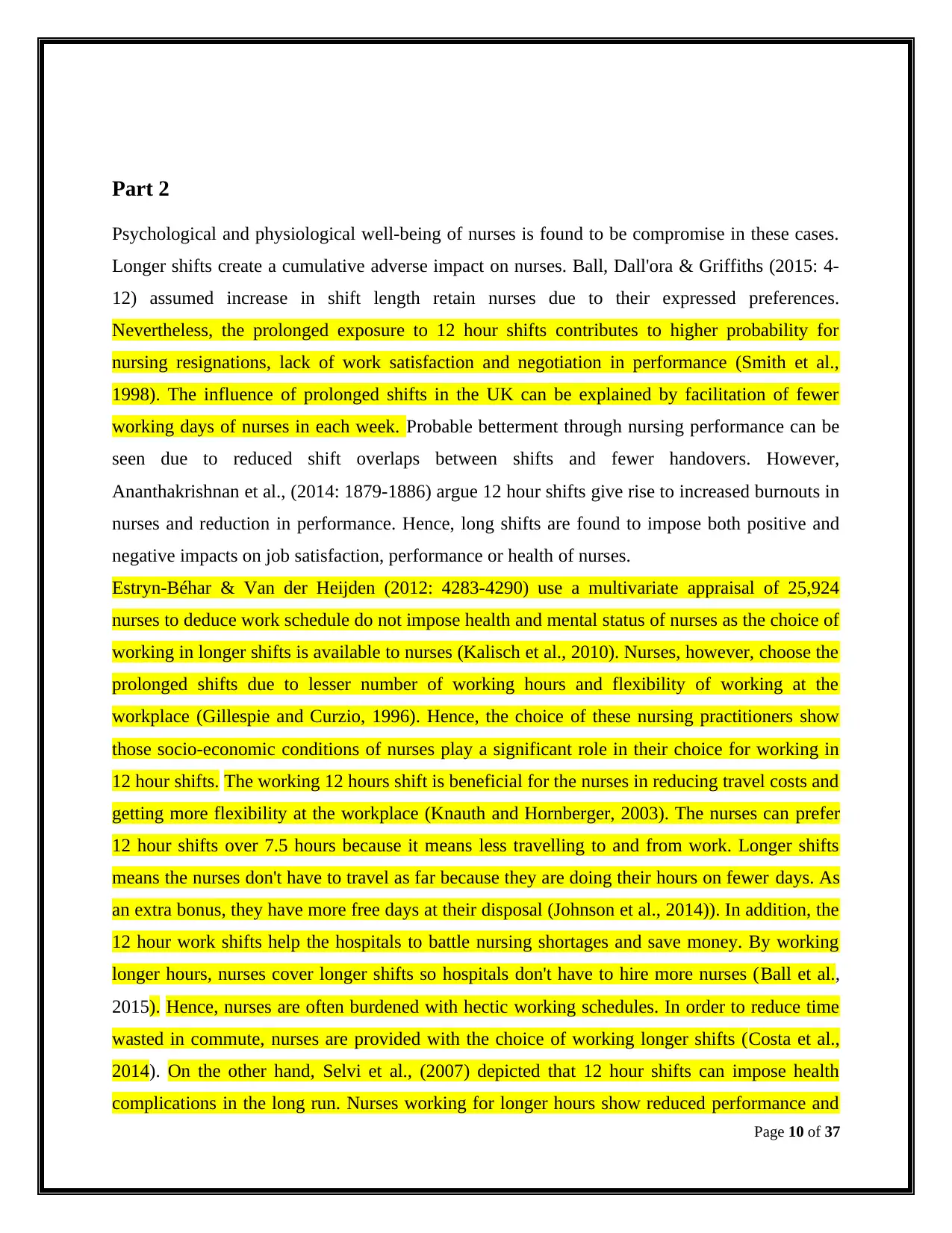
Part 2
Psychological and physiological well-being of nurses is found to be compromise in these cases.
Longer shifts create a cumulative adverse impact on nurses. Ball, Dall'ora & Griffiths (2015: 4-
12) assumed increase in shift length retain nurses due to their expressed preferences.
Nevertheless, the prolonged exposure to 12 hour shifts contributes to higher probability for
nursing resignations, lack of work satisfaction and negotiation in performance (Smith et al.,
1998). The influence of prolonged shifts in the UK can be explained by facilitation of fewer
working days of nurses in each week. Probable betterment through nursing performance can be
seen due to reduced shift overlaps between shifts and fewer handovers. However,
Ananthakrishnan et al., (2014: 1879-1886) argue 12 hour shifts give rise to increased burnouts in
nurses and reduction in performance. Hence, long shifts are found to impose both positive and
negative impacts on job satisfaction, performance or health of nurses.
Estryn-Béhar & Van der Heijden (2012: 4283-4290) use a multivariate appraisal of 25,924
nurses to deduce work schedule do not impose health and mental status of nurses as the choice of
working in longer shifts is available to nurses (Kalisch et al., 2010). Nurses, however, choose the
prolonged shifts due to lesser number of working hours and flexibility of working at the
workplace (Gillespie and Curzio, 1996). Hence, the choice of these nursing practitioners show
those socio-economic conditions of nurses play a significant role in their choice for working in
12 hour shifts. The working 12 hours shift is beneficial for the nurses in reducing travel costs and
getting more flexibility at the workplace (Knauth and Hornberger, 2003). The nurses can prefer
12 hour shifts over 7.5 hours because it means less travelling to and from work. Longer shifts
means the nurses don't have to travel as far because they are doing their hours on fewer days. As
an extra bonus, they have more free days at their disposal (Johnson et al., 2014)). In addition, the
12 hour work shifts help the hospitals to battle nursing shortages and save money. By working
longer hours, nurses cover longer shifts so hospitals don't have to hire more nurses (Ball et al.,
2015). Hence, nurses are often burdened with hectic working schedules. In order to reduce time
wasted in commute, nurses are provided with the choice of working longer shifts (Costa et al.,
2014). On the other hand, Selvi et al., (2007) depicted that 12 hour shifts can impose health
complications in the long run. Nurses working for longer hours show reduced performance and
Page 10 of 37
Psychological and physiological well-being of nurses is found to be compromise in these cases.
Longer shifts create a cumulative adverse impact on nurses. Ball, Dall'ora & Griffiths (2015: 4-
12) assumed increase in shift length retain nurses due to their expressed preferences.
Nevertheless, the prolonged exposure to 12 hour shifts contributes to higher probability for
nursing resignations, lack of work satisfaction and negotiation in performance (Smith et al.,
1998). The influence of prolonged shifts in the UK can be explained by facilitation of fewer
working days of nurses in each week. Probable betterment through nursing performance can be
seen due to reduced shift overlaps between shifts and fewer handovers. However,
Ananthakrishnan et al., (2014: 1879-1886) argue 12 hour shifts give rise to increased burnouts in
nurses and reduction in performance. Hence, long shifts are found to impose both positive and
negative impacts on job satisfaction, performance or health of nurses.
Estryn-Béhar & Van der Heijden (2012: 4283-4290) use a multivariate appraisal of 25,924
nurses to deduce work schedule do not impose health and mental status of nurses as the choice of
working in longer shifts is available to nurses (Kalisch et al., 2010). Nurses, however, choose the
prolonged shifts due to lesser number of working hours and flexibility of working at the
workplace (Gillespie and Curzio, 1996). Hence, the choice of these nursing practitioners show
those socio-economic conditions of nurses play a significant role in their choice for working in
12 hour shifts. The working 12 hours shift is beneficial for the nurses in reducing travel costs and
getting more flexibility at the workplace (Knauth and Hornberger, 2003). The nurses can prefer
12 hour shifts over 7.5 hours because it means less travelling to and from work. Longer shifts
means the nurses don't have to travel as far because they are doing their hours on fewer days. As
an extra bonus, they have more free days at their disposal (Johnson et al., 2014)). In addition, the
12 hour work shifts help the hospitals to battle nursing shortages and save money. By working
longer hours, nurses cover longer shifts so hospitals don't have to hire more nurses (Ball et al.,
2015). Hence, nurses are often burdened with hectic working schedules. In order to reduce time
wasted in commute, nurses are provided with the choice of working longer shifts (Costa et al.,
2014). On the other hand, Selvi et al., (2007) depicted that 12 hour shifts can impose health
complications in the long run. Nurses working for longer hours show reduced performance and
Page 10 of 37
Paraphrase This Document
Need a fresh take? Get an instant paraphrase of this document with our AI Paraphraser
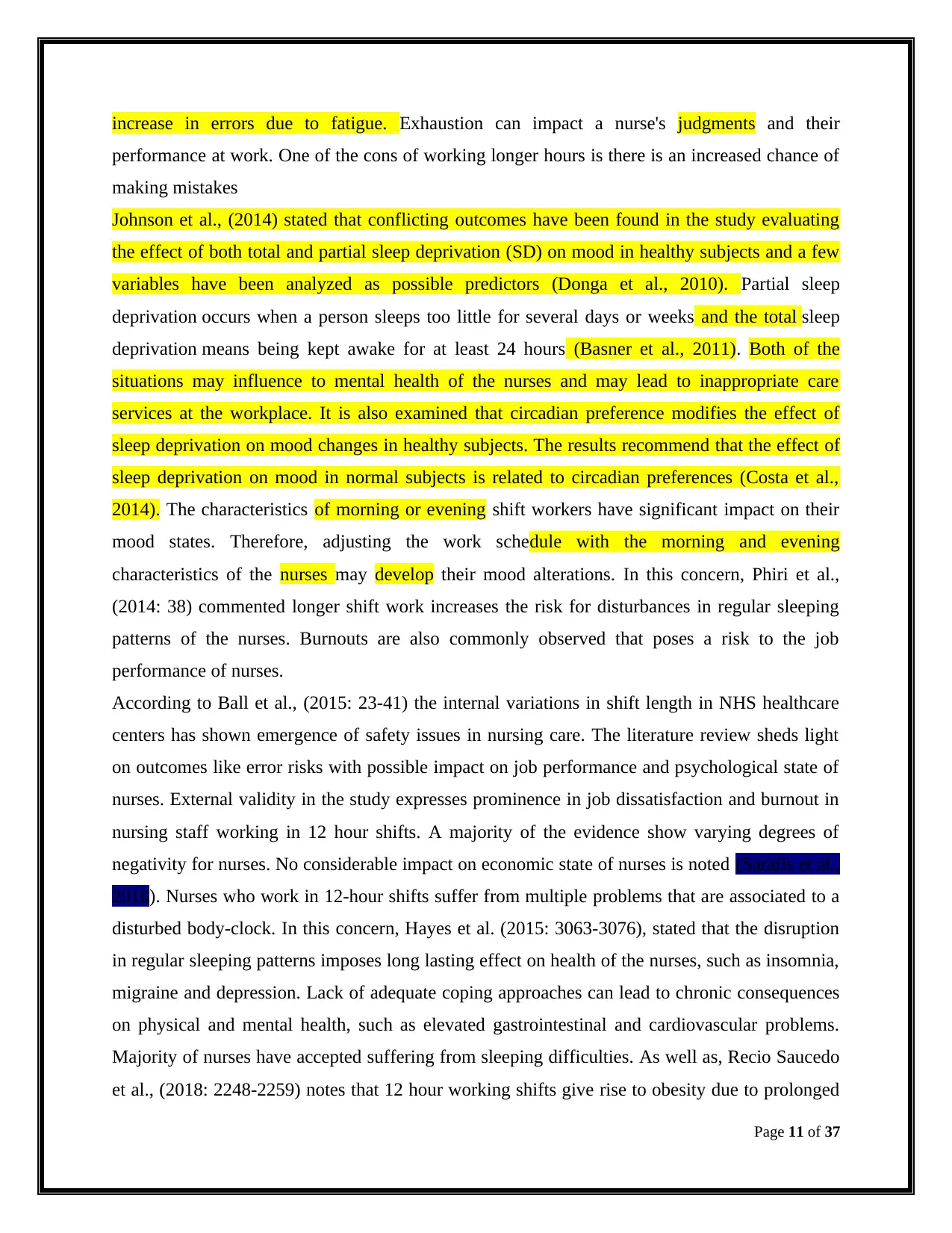
increase in errors due to fatigue. Exhaustion can impact a nurse's judgments and their
performance at work. One of the cons of working longer hours is there is an increased chance of
making mistakes
Johnson et al., (2014) stated that conflicting outcomes have been found in the study evaluating
the effect of both total and partial sleep deprivation (SD) on mood in healthy subjects and a few
variables have been analyzed as possible predictors (Donga et al., 2010). Partial sleep
deprivation occurs when a person sleeps too little for several days or weeks and the total sleep
deprivation means being kept awake for at least 24 hours (Basner et al., 2011). Both of the
situations may influence to mental health of the nurses and may lead to inappropriate care
services at the workplace. It is also examined that circadian preference modifies the effect of
sleep deprivation on mood changes in healthy subjects. The results recommend that the effect of
sleep deprivation on mood in normal subjects is related to circadian preferences (Costa et al.,
2014). The characteristics of morning or evening shift workers have significant impact on their
mood states. Therefore, adjusting the work schedule with the morning and evening
characteristics of the nurses may develop their mood alterations. In this concern, Phiri et al.,
(2014: 38) commented longer shift work increases the risk for disturbances in regular sleeping
patterns of the nurses. Burnouts are also commonly observed that poses a risk to the job
performance of nurses.
According to Ball et al., (2015: 23-41) the internal variations in shift length in NHS healthcare
centers has shown emergence of safety issues in nursing care. The literature review sheds light
on outcomes like error risks with possible impact on job performance and psychological state of
nurses. External validity in the study expresses prominence in job dissatisfaction and burnout in
nursing staff working in 12 hour shifts. A majority of the evidence show varying degrees of
negativity for nurses. No considerable impact on economic state of nurses is noted (Sarafis et al.,
2016). Nurses who work in 12-hour shifts suffer from multiple problems that are associated to a
disturbed body-clock. In this concern, Hayes et al. (2015: 3063-3076), stated that the disruption
in regular sleeping patterns imposes long lasting effect on health of the nurses, such as insomnia,
migraine and depression. Lack of adequate coping approaches can lead to chronic consequences
on physical and mental health, such as elevated gastrointestinal and cardiovascular problems.
Majority of nurses have accepted suffering from sleeping difficulties. As well as, Recio Saucedo
et al., (2018: 2248-2259) notes that 12 hour working shifts give rise to obesity due to prolonged
Page 11 of 37
performance at work. One of the cons of working longer hours is there is an increased chance of
making mistakes
Johnson et al., (2014) stated that conflicting outcomes have been found in the study evaluating
the effect of both total and partial sleep deprivation (SD) on mood in healthy subjects and a few
variables have been analyzed as possible predictors (Donga et al., 2010). Partial sleep
deprivation occurs when a person sleeps too little for several days or weeks and the total sleep
deprivation means being kept awake for at least 24 hours (Basner et al., 2011). Both of the
situations may influence to mental health of the nurses and may lead to inappropriate care
services at the workplace. It is also examined that circadian preference modifies the effect of
sleep deprivation on mood changes in healthy subjects. The results recommend that the effect of
sleep deprivation on mood in normal subjects is related to circadian preferences (Costa et al.,
2014). The characteristics of morning or evening shift workers have significant impact on their
mood states. Therefore, adjusting the work schedule with the morning and evening
characteristics of the nurses may develop their mood alterations. In this concern, Phiri et al.,
(2014: 38) commented longer shift work increases the risk for disturbances in regular sleeping
patterns of the nurses. Burnouts are also commonly observed that poses a risk to the job
performance of nurses.
According to Ball et al., (2015: 23-41) the internal variations in shift length in NHS healthcare
centers has shown emergence of safety issues in nursing care. The literature review sheds light
on outcomes like error risks with possible impact on job performance and psychological state of
nurses. External validity in the study expresses prominence in job dissatisfaction and burnout in
nursing staff working in 12 hour shifts. A majority of the evidence show varying degrees of
negativity for nurses. No considerable impact on economic state of nurses is noted (Sarafis et al.,
2016). Nurses who work in 12-hour shifts suffer from multiple problems that are associated to a
disturbed body-clock. In this concern, Hayes et al. (2015: 3063-3076), stated that the disruption
in regular sleeping patterns imposes long lasting effect on health of the nurses, such as insomnia,
migraine and depression. Lack of adequate coping approaches can lead to chronic consequences
on physical and mental health, such as elevated gastrointestinal and cardiovascular problems.
Majority of nurses have accepted suffering from sleeping difficulties. As well as, Recio Saucedo
et al., (2018: 2248-2259) notes that 12 hour working shifts give rise to obesity due to prolonged
Page 11 of 37
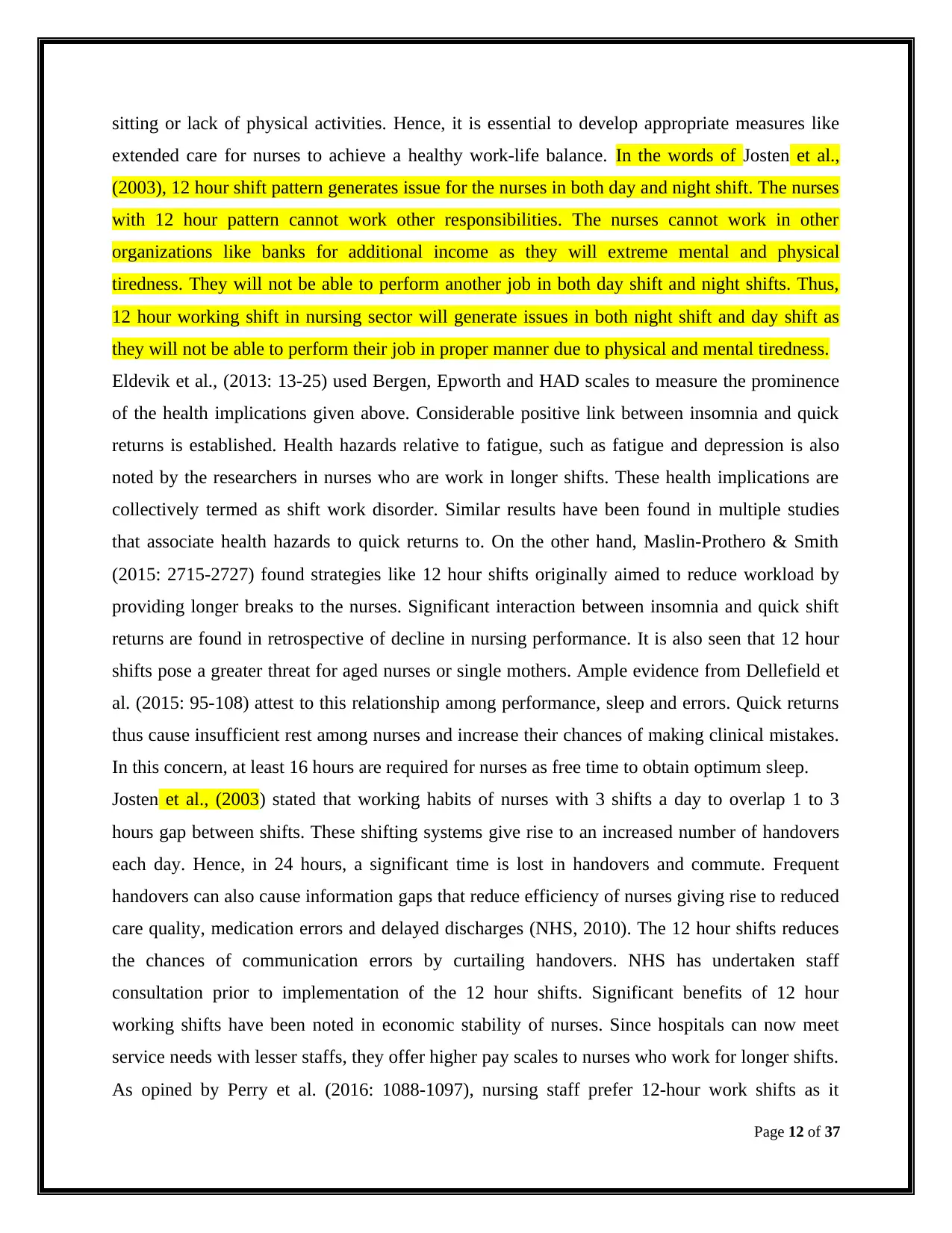
sitting or lack of physical activities. Hence, it is essential to develop appropriate measures like
extended care for nurses to achieve a healthy work-life balance. In the words of Josten et al.,
(2003), 12 hour shift pattern generates issue for the nurses in both day and night shift. The nurses
with 12 hour pattern cannot work other responsibilities. The nurses cannot work in other
organizations like banks for additional income as they will extreme mental and physical
tiredness. They will not be able to perform another job in both day shift and night shifts. Thus,
12 hour working shift in nursing sector will generate issues in both night shift and day shift as
they will not be able to perform their job in proper manner due to physical and mental tiredness.
Eldevik et al., (2013: 13-25) used Bergen, Epworth and HAD scales to measure the prominence
of the health implications given above. Considerable positive link between insomnia and quick
returns is established. Health hazards relative to fatigue, such as fatigue and depression is also
noted by the researchers in nurses who are work in longer shifts. These health implications are
collectively termed as shift work disorder. Similar results have been found in multiple studies
that associate health hazards to quick returns to. On the other hand, Maslin-Prothero & Smith
(2015: 2715-2727) found strategies like 12 hour shifts originally aimed to reduce workload by
providing longer breaks to the nurses. Significant interaction between insomnia and quick shift
returns are found in retrospective of decline in nursing performance. It is also seen that 12 hour
shifts pose a greater threat for aged nurses or single mothers. Ample evidence from Dellefield et
al. (2015: 95-108) attest to this relationship among performance, sleep and errors. Quick returns
thus cause insufficient rest among nurses and increase their chances of making clinical mistakes.
In this concern, at least 16 hours are required for nurses as free time to obtain optimum sleep.
Josten et al., (2003) stated that working habits of nurses with 3 shifts a day to overlap 1 to 3
hours gap between shifts. These shifting systems give rise to an increased number of handovers
each day. Hence, in 24 hours, a significant time is lost in handovers and commute. Frequent
handovers can also cause information gaps that reduce efficiency of nurses giving rise to reduced
care quality, medication errors and delayed discharges (NHS, 2010). The 12 hour shifts reduces
the chances of communication errors by curtailing handovers. NHS has undertaken staff
consultation prior to implementation of the 12 hour shifts. Significant benefits of 12 hour
working shifts have been noted in economic stability of nurses. Since hospitals can now meet
service needs with lesser staffs, they offer higher pay scales to nurses who work for longer shifts.
As opined by Perry et al. (2016: 1088-1097), nursing staff prefer 12-hour work shifts as it
Page 12 of 37
extended care for nurses to achieve a healthy work-life balance. In the words of Josten et al.,
(2003), 12 hour shift pattern generates issue for the nurses in both day and night shift. The nurses
with 12 hour pattern cannot work other responsibilities. The nurses cannot work in other
organizations like banks for additional income as they will extreme mental and physical
tiredness. They will not be able to perform another job in both day shift and night shifts. Thus,
12 hour working shift in nursing sector will generate issues in both night shift and day shift as
they will not be able to perform their job in proper manner due to physical and mental tiredness.
Eldevik et al., (2013: 13-25) used Bergen, Epworth and HAD scales to measure the prominence
of the health implications given above. Considerable positive link between insomnia and quick
returns is established. Health hazards relative to fatigue, such as fatigue and depression is also
noted by the researchers in nurses who are work in longer shifts. These health implications are
collectively termed as shift work disorder. Similar results have been found in multiple studies
that associate health hazards to quick returns to. On the other hand, Maslin-Prothero & Smith
(2015: 2715-2727) found strategies like 12 hour shifts originally aimed to reduce workload by
providing longer breaks to the nurses. Significant interaction between insomnia and quick shift
returns are found in retrospective of decline in nursing performance. It is also seen that 12 hour
shifts pose a greater threat for aged nurses or single mothers. Ample evidence from Dellefield et
al. (2015: 95-108) attest to this relationship among performance, sleep and errors. Quick returns
thus cause insufficient rest among nurses and increase their chances of making clinical mistakes.
In this concern, at least 16 hours are required for nurses as free time to obtain optimum sleep.
Josten et al., (2003) stated that working habits of nurses with 3 shifts a day to overlap 1 to 3
hours gap between shifts. These shifting systems give rise to an increased number of handovers
each day. Hence, in 24 hours, a significant time is lost in handovers and commute. Frequent
handovers can also cause information gaps that reduce efficiency of nurses giving rise to reduced
care quality, medication errors and delayed discharges (NHS, 2010). The 12 hour shifts reduces
the chances of communication errors by curtailing handovers. NHS has undertaken staff
consultation prior to implementation of the 12 hour shifts. Significant benefits of 12 hour
working shifts have been noted in economic stability of nurses. Since hospitals can now meet
service needs with lesser staffs, they offer higher pay scales to nurses who work for longer shifts.
As opined by Perry et al. (2016: 1088-1097), nursing staff prefer 12-hour work shifts as it
Page 12 of 37
⊘ This is a preview!⊘
Do you want full access?
Subscribe today to unlock all pages.

Trusted by 1+ million students worldwide
1 out of 37
Related Documents
Your All-in-One AI-Powered Toolkit for Academic Success.
+13062052269
info@desklib.com
Available 24*7 on WhatsApp / Email
![[object Object]](/_next/static/media/star-bottom.7253800d.svg)
Unlock your academic potential
Copyright © 2020–2025 A2Z Services. All Rights Reserved. Developed and managed by ZUCOL.





